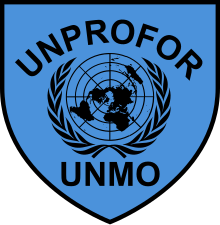
Back مناطق الأمم المتحدة الآمنة Arabic Zaštićene zone Ujedinjenih nacija BS UN-Schutzzone German Zones de sécurité des Nations Unies French 유엔 안전구역 Korean VN-veilige gebieden Dutch FN-erklært sikker sone NB Strefy bezpieczeństwa ONZ w Bośni i Hercegowinie Polish Zonas de segurança das Nações Unidas na Bósnia Portuguese Сигурна подручја Организације уједињених нација Serbian
This article needs additional citations for verification. (January 2017) |
You can help expand this article with text translated from the corresponding article in German. (October 2015) Click [show] for important translation instructions.
|
 Insignia of the UNPROFOR | |
 | |
| Formation | 16 April 1993 |
|---|---|
| Dissolved | 14 December 1995 |
| Location |
|
Official languages | Bosnian & official languages of the United Nations |
Lieutenant-General | Lars-Eric Wahlgren |
United Nations Safe Areas (UN Safe Areas) were humanitarian corridors established in 1993 in the territory of Bosnia and Herzegovina during the Bosnian War by several resolutions of the United Nations Security Council.[1]
On 16 April 1993, with the United Nations Security Council Resolution 819 the Srebrenica enclave was declared a safe area. On 6 May 1993, the United Nations Security Council Resolution 824 further extended the status to Sarajevo, Žepa, Goražde, Tuzla and Bihać. These cities and territories were placed under the protection of the UN peacekeeping units UNPROFOR.
The establishment of the UN Safe Areas is considered today to be one of the most controversial decisions of the United Nations. The resolutions were unclear about the procedure by which these safe areas were to be protected in a war zone like Bosnia and Herzegovina. The resolution created a difficult diplomatic situation because the member states that voted in favor of it were, for political reasons, not willing to take the necessary steps to ensure the security of the safe areas.
In 1995 the situation in UN Safe Areas was deteriorating, and it led to a diplomatic crisis which culminated in the Srebrenica massacre; one of the worst atrocities in Europe since World War II. The Security Council Resolution 819 and 836 had designated Srebrenica a "safe area" to be protected using "all necessary means, including the use of force". Continued attacks on UN Safe Areas as well as the continued Siege of Sarajevo also ultimately resulted in NATO intervention in Bosnia and Herzegovina named Operation Deliberate Force.
By the end of the war every one of the Safe Areas had been attacked by the Army of Republika Srpska, and Srebrenica and Žepa were overrun.
- ^ Marcus Tanner (7 June 1993). "Bosnia's 'Safe Areas': West sets the stage for a human tragedy: The creation of UN 'safe' refugee zones proceeds apace. In these disease-ridden camps thousands of orphaned Muslim children, with no hope for the future, will turn to crime or terrorism". The Independent. Archived from the original on 4 January 2017. Retrieved 4 January 2017.